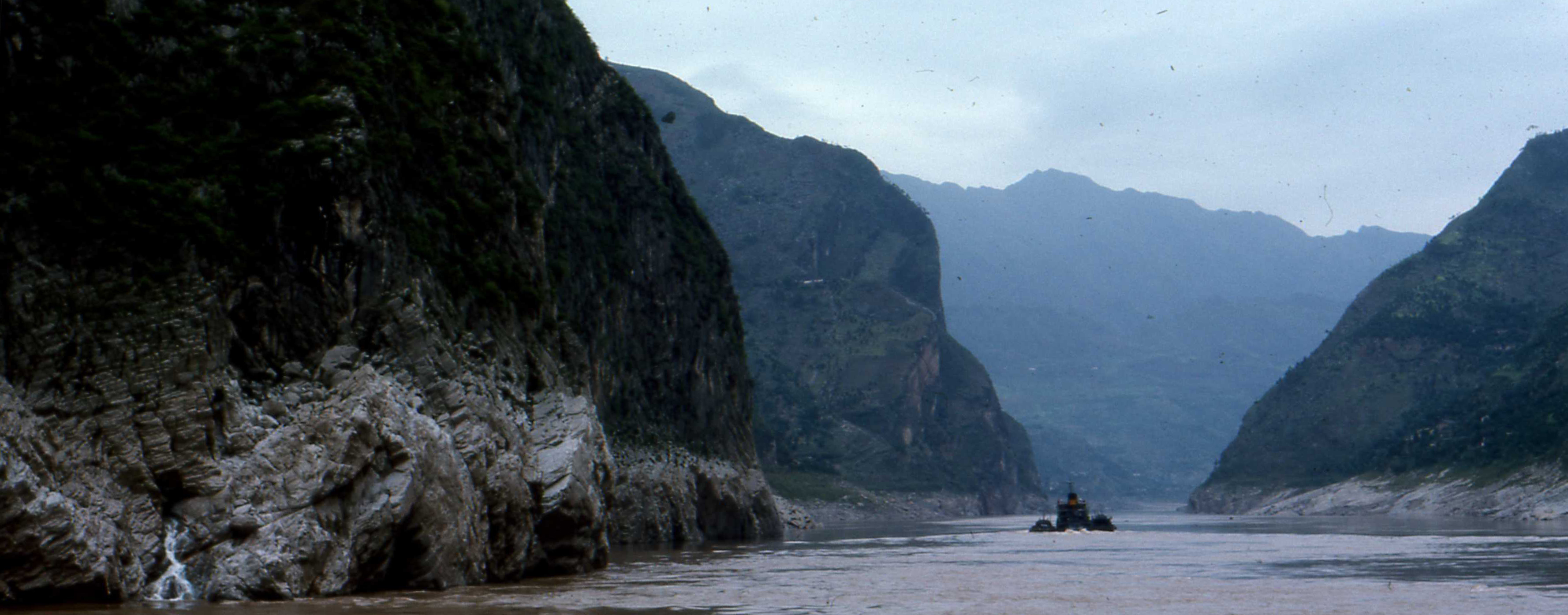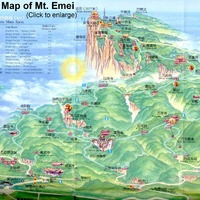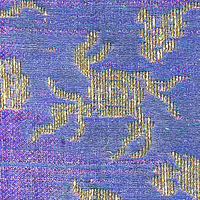-
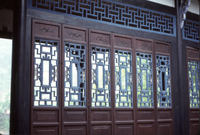 1978 Fulong Guan Temple Rectangular Lattice
1978 Fulong Guan Temple Rectangular Lattice Lattice window panes arranged in groups of six vertical panels has mostly rectangles within the design. Above these panels is another lattice window oriented horizontally and featuring a pattern that emulates plain weave fabric. There are two groups of this arrangement visible in the photo.
-
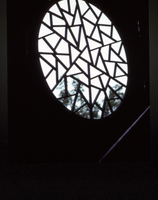 1978 Fulong Guan Temple Circular Lattice
1978 Fulong Guan Temple Circular Lattice Close up of circular lattice window at Fulong Guan Temple. Pattern has a triangle in the center, with asymmetrically placed triangles and irregularly shaped rhombuses that appear to swirl in a clockwise direction.
-
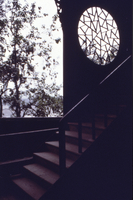 1978 Fulong Guan Temple Stairs to Lattice
1978 Fulong Guan Temple Stairs to Lattice Stairs lead up to a wall with a circular lattice window. The river and shoreline can be seen in the background between the treetops.
-
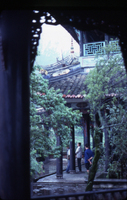 1978 Fulong Guan Temple through an Archway
1978 Fulong Guan Temple through an Archway Several men can be seen through an archway standing between large columns at Fulong Guan Temple. The pavilion can be seen in the background, and a balcony up above.
-
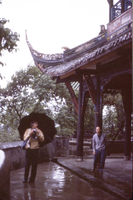 1978 Fulong Guan Temple in the Rain
1978 Fulong Guan Temple in the Rain Two men stand in a courtyard at the Fulong Guan Temple. One of them is Chinese. The other one is probably a delegation member. He holds an umbrella and camera.
-
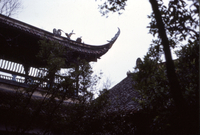 1978 Fulong Guan Temple Rooftop
1978 Fulong Guan Temple Rooftop Whimsical figures grace the curved rooftop of a balcony in the Fulong Guan Temple.
-
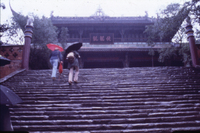 1978 Front Steps of Fulong Guan Temple
1978 Front Steps of Fulong Guan Temple Two people with umbrellas ascend the age-worn stone steps of the Fulong Guan Temple at its front entrance.
-
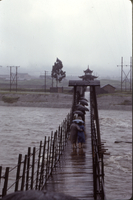 1978 New Anlan Bridge Facing West
1978 New Anlan Bridge Facing West Taken from the Anlan Bridge facing toward the western shoreline. Powerlines and a terminus pavilion can be seen on the shore. A group of people with umbrellas are walking on the bridge. Supporting metal cables are visible in the foreground.
-
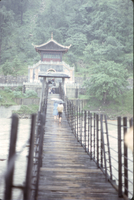 1978 New Anlan Bridge Facing Pavillion
1978 New Anlan Bridge Facing Pavillion Taken from the Anlan Bridge facing toward the archway pavilion on the eastern shoreline. A large group of people can be seen on the bridge between the pavilion and the supporting beams. In the foreground one can see the metal cables.
-
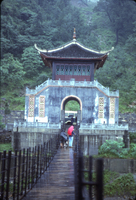 1978 New Anlan Bridge Pavillion
1978 New Anlan Bridge Pavillion Taken from the Anlan Bridge facing toward the archway pavilion on the eastern shoreline. Portions of Er Wang Temple are visible on the mountainside behind. Two people with umbrellas, one with a bicycle are nearing the pavilion.
-
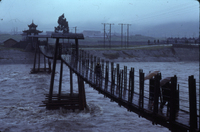 1978 New Anlan Bridge from East Shore
1978 New Anlan Bridge from East Shore The east side of the Anlan Bridge taken from the shore of the Inner River. Several people are crossing with and without umbrellas. The Fishmouth can be seen in the right. Powerlines are seen to cross the river and continue westward. There are stucco houses on the western shore.
-
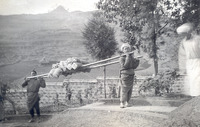 Wedding Procession - Dowry Pillows
Wedding Procession - Dowry Pillows Two men carry a portion of the bride's dowry, a group of pillows. The hills surrounding Renshou can be seen in the background.
-
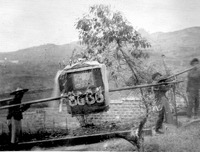 Wedding Procession - Bridal Chair
Wedding Procession - Bridal Chair Three men are seen carrying a bridal chair with the bride hidden inside. The chair is adorned with silk panels and other indiscernible decorations. The hills surrounding Renshou can be seen in the background.
-
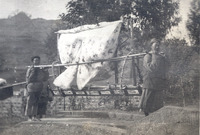 Wedding Procession - Embroidery Dowry
Wedding Procession - Embroidery Dowry Two men carry a portion of the bride's dowry, an embroidered bed curtain with a wooden frame. The decorative side panels of the frame are hanging horizontally at the bottom of the load. The hills surrounding Renshou can be seen in the background.
-
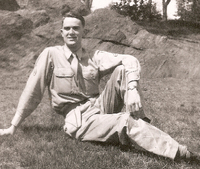 Corporal Donald Earl Willmott
Corporal Donald Earl Willmott Don Willmott sits on a lawn in a casual pose wearing his army fatigues. The rank badge for corporals is sewn to both sleeves of his shirt, and there is a pistol holster strapped to his belt.
-
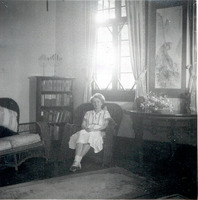 Kay Willmott in WCUU Living Room
Kay Willmott in WCUU Living Room Kay Willmott poses in a wicker chair in the living room of their house on the WCUU campus. A Chinese scroll with a tiger motif hangs on the wall beside her. The Chinese carpet at her feet is now in Cory Willmott's collection.
-
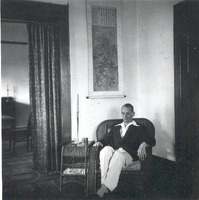 Earl Willmott in WCUU Living Room
Earl Willmott in WCUU Living Room Earl Willmott poses in a wicker chair in the living room of their house on the WCUU campus. A Chinese scroll hangs on the wall behind him.
-
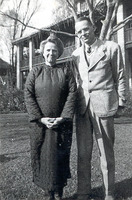 Earl and Kay Willmott in Front Yard
Earl and Kay Willmott in Front Yard Earl and Kay Willmott are standing in the front yard of their house on the WCUU campus. The season is fall. Kay wears her fur-lined silk changshan to keep warm and as a marker of her status as a scholar.
-
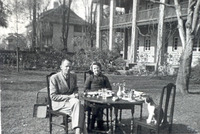 Earl and Kay Willmott Having Tea in Front Yard
Earl and Kay Willmott Having Tea in Front Yard Earl and Kay Willmott are seated at a table spread for afternoon tea in the front yard of their house on the WCUU campus. "Yowler" the cat is sitting on a chair opposite them. The houses on "Canadian Row" can be seen in the background. The season is fall. Kay wears her fur-lined silk changshan to keep warm and as a marker of her status as a scholar.
-
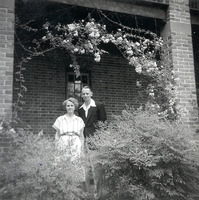 Earl and Kay Willmott on Verandah
Earl and Kay Willmott on Verandah Earl and Kay Willmott pose for a portrait on the verandah of their house on the WCUU campus, Chengdu. Rose bushes hang from a rope trellis above their heads.
-
 Toddlers Don Willmott and Norm Endicott
Toddlers Don Willmott and Norm Endicott Young Don (left) and Norm (right) play together on a porch surrounded by numerous and various toys. They each have child-sized chairs as well.
-
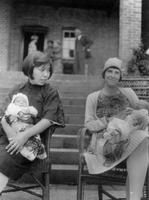 Kay Willmott at Endicott's Front Porch
Kay Willmott at Endicott's Front Porch Kay Willmott (right) holds infant Richard Curtis (b 1930-03-19) and an unidentified Chinese woman (left) holds an infant that is probably Shirley Jane Endicott (b 1930-04-19). The two are seated in wicker chairs in front of the steps leading to the Endicott's porch. A group of four people are standing on the porch.
-
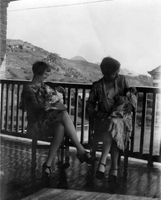 New Mothers at Duckling Pond
New Mothers at Duckling Pond Kay Willmott (left) holds infant Richard Curtis (b 1930-03-19) and Mary Austin Endicott (right) holds infant Shirley Jane (b 1930-04-19). The two mothers are stylishly dressed in silk print dresses and high heels.
-
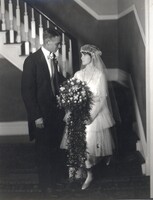 Willmott Wedding Portrait 3
Willmott Wedding Portrait 3 Formal portrait of Lesslie Earl Willmott and Mary Katharine Geyer facing each other on their wedding day. The groom wears a tuxedo with a white vest and bowtie. The bride wears a white dress with a three tiered skirt that was considered unconventionally short for the time period. She also sports bobbed hair.
-
 Willmott Wedding Portrait 2
Willmott Wedding Portrait 2 Formal portrait of Lesslie Earl Willmott and Mary Katharine Geyer on their wedding day. The groom wears a tuxedo with a white vest and bowtie. The bride wears a white dress with a three tiered skirt that was considered unconventionally short for the time period. She also sports bobbed hair.
 1978 Fulong Guan Temple Rectangular Lattice Lattice window panes arranged in groups of six vertical panels has mostly rectangles within the design. Above these panels is another lattice window oriented horizontally and featuring a pattern that emulates plain weave fabric. There are two groups of this arrangement visible in the photo.
1978 Fulong Guan Temple Rectangular Lattice Lattice window panes arranged in groups of six vertical panels has mostly rectangles within the design. Above these panels is another lattice window oriented horizontally and featuring a pattern that emulates plain weave fabric. There are two groups of this arrangement visible in the photo. 1978 Fulong Guan Temple Circular Lattice Close up of circular lattice window at Fulong Guan Temple. Pattern has a triangle in the center, with asymmetrically placed triangles and irregularly shaped rhombuses that appear to swirl in a clockwise direction.
1978 Fulong Guan Temple Circular Lattice Close up of circular lattice window at Fulong Guan Temple. Pattern has a triangle in the center, with asymmetrically placed triangles and irregularly shaped rhombuses that appear to swirl in a clockwise direction. 1978 Fulong Guan Temple Stairs to Lattice Stairs lead up to a wall with a circular lattice window. The river and shoreline can be seen in the background between the treetops.
1978 Fulong Guan Temple Stairs to Lattice Stairs lead up to a wall with a circular lattice window. The river and shoreline can be seen in the background between the treetops. 1978 Fulong Guan Temple through an Archway Several men can be seen through an archway standing between large columns at Fulong Guan Temple. The pavilion can be seen in the background, and a balcony up above.
1978 Fulong Guan Temple through an Archway Several men can be seen through an archway standing between large columns at Fulong Guan Temple. The pavilion can be seen in the background, and a balcony up above. 1978 Fulong Guan Temple in the Rain Two men stand in a courtyard at the Fulong Guan Temple. One of them is Chinese. The other one is probably a delegation member. He holds an umbrella and camera.
1978 Fulong Guan Temple in the Rain Two men stand in a courtyard at the Fulong Guan Temple. One of them is Chinese. The other one is probably a delegation member. He holds an umbrella and camera. 1978 Fulong Guan Temple Rooftop Whimsical figures grace the curved rooftop of a balcony in the Fulong Guan Temple.
1978 Fulong Guan Temple Rooftop Whimsical figures grace the curved rooftop of a balcony in the Fulong Guan Temple. 1978 Front Steps of Fulong Guan Temple Two people with umbrellas ascend the age-worn stone steps of the Fulong Guan Temple at its front entrance.
1978 Front Steps of Fulong Guan Temple Two people with umbrellas ascend the age-worn stone steps of the Fulong Guan Temple at its front entrance. 1978 New Anlan Bridge Facing West Taken from the Anlan Bridge facing toward the western shoreline. Powerlines and a terminus pavilion can be seen on the shore. A group of people with umbrellas are walking on the bridge. Supporting metal cables are visible in the foreground.
1978 New Anlan Bridge Facing West Taken from the Anlan Bridge facing toward the western shoreline. Powerlines and a terminus pavilion can be seen on the shore. A group of people with umbrellas are walking on the bridge. Supporting metal cables are visible in the foreground. 1978 New Anlan Bridge Facing Pavillion Taken from the Anlan Bridge facing toward the archway pavilion on the eastern shoreline. A large group of people can be seen on the bridge between the pavilion and the supporting beams. In the foreground one can see the metal cables.
1978 New Anlan Bridge Facing Pavillion Taken from the Anlan Bridge facing toward the archway pavilion on the eastern shoreline. A large group of people can be seen on the bridge between the pavilion and the supporting beams. In the foreground one can see the metal cables. 1978 New Anlan Bridge Pavillion Taken from the Anlan Bridge facing toward the archway pavilion on the eastern shoreline. Portions of Er Wang Temple are visible on the mountainside behind. Two people with umbrellas, one with a bicycle are nearing the pavilion.
1978 New Anlan Bridge Pavillion Taken from the Anlan Bridge facing toward the archway pavilion on the eastern shoreline. Portions of Er Wang Temple are visible on the mountainside behind. Two people with umbrellas, one with a bicycle are nearing the pavilion. 1978 New Anlan Bridge from East Shore The east side of the Anlan Bridge taken from the shore of the Inner River. Several people are crossing with and without umbrellas. The Fishmouth can be seen in the right. Powerlines are seen to cross the river and continue westward. There are stucco houses on the western shore.
1978 New Anlan Bridge from East Shore The east side of the Anlan Bridge taken from the shore of the Inner River. Several people are crossing with and without umbrellas. The Fishmouth can be seen in the right. Powerlines are seen to cross the river and continue westward. There are stucco houses on the western shore. Wedding Procession - Dowry Pillows Two men carry a portion of the bride's dowry, a group of pillows. The hills surrounding Renshou can be seen in the background.
Wedding Procession - Dowry Pillows Two men carry a portion of the bride's dowry, a group of pillows. The hills surrounding Renshou can be seen in the background. Wedding Procession - Bridal Chair Three men are seen carrying a bridal chair with the bride hidden inside. The chair is adorned with silk panels and other indiscernible decorations. The hills surrounding Renshou can be seen in the background.
Wedding Procession - Bridal Chair Three men are seen carrying a bridal chair with the bride hidden inside. The chair is adorned with silk panels and other indiscernible decorations. The hills surrounding Renshou can be seen in the background. Wedding Procession - Embroidery Dowry Two men carry a portion of the bride's dowry, an embroidered bed curtain with a wooden frame. The decorative side panels of the frame are hanging horizontally at the bottom of the load. The hills surrounding Renshou can be seen in the background.
Wedding Procession - Embroidery Dowry Two men carry a portion of the bride's dowry, an embroidered bed curtain with a wooden frame. The decorative side panels of the frame are hanging horizontally at the bottom of the load. The hills surrounding Renshou can be seen in the background. Corporal Donald Earl Willmott Don Willmott sits on a lawn in a casual pose wearing his army fatigues. The rank badge for corporals is sewn to both sleeves of his shirt, and there is a pistol holster strapped to his belt.
Corporal Donald Earl Willmott Don Willmott sits on a lawn in a casual pose wearing his army fatigues. The rank badge for corporals is sewn to both sleeves of his shirt, and there is a pistol holster strapped to his belt. Kay Willmott in WCUU Living Room Kay Willmott poses in a wicker chair in the living room of their house on the WCUU campus. A Chinese scroll with a tiger motif hangs on the wall beside her. The Chinese carpet at her feet is now in Cory Willmott's collection.
Kay Willmott in WCUU Living Room Kay Willmott poses in a wicker chair in the living room of their house on the WCUU campus. A Chinese scroll with a tiger motif hangs on the wall beside her. The Chinese carpet at her feet is now in Cory Willmott's collection. Earl Willmott in WCUU Living Room Earl Willmott poses in a wicker chair in the living room of their house on the WCUU campus. A Chinese scroll hangs on the wall behind him.
Earl Willmott in WCUU Living Room Earl Willmott poses in a wicker chair in the living room of their house on the WCUU campus. A Chinese scroll hangs on the wall behind him. Earl and Kay Willmott in Front Yard Earl and Kay Willmott are standing in the front yard of their house on the WCUU campus. The season is fall. Kay wears her fur-lined silk changshan to keep warm and as a marker of her status as a scholar.
Earl and Kay Willmott in Front Yard Earl and Kay Willmott are standing in the front yard of their house on the WCUU campus. The season is fall. Kay wears her fur-lined silk changshan to keep warm and as a marker of her status as a scholar. Earl and Kay Willmott Having Tea in Front Yard Earl and Kay Willmott are seated at a table spread for afternoon tea in the front yard of their house on the WCUU campus. "Yowler" the cat is sitting on a chair opposite them. The houses on "Canadian Row" can be seen in the background. The season is fall. Kay wears her fur-lined silk changshan to keep warm and as a marker of her status as a scholar.
Earl and Kay Willmott Having Tea in Front Yard Earl and Kay Willmott are seated at a table spread for afternoon tea in the front yard of their house on the WCUU campus. "Yowler" the cat is sitting on a chair opposite them. The houses on "Canadian Row" can be seen in the background. The season is fall. Kay wears her fur-lined silk changshan to keep warm and as a marker of her status as a scholar. Earl and Kay Willmott on Verandah Earl and Kay Willmott pose for a portrait on the verandah of their house on the WCUU campus, Chengdu. Rose bushes hang from a rope trellis above their heads.
Earl and Kay Willmott on Verandah Earl and Kay Willmott pose for a portrait on the verandah of their house on the WCUU campus, Chengdu. Rose bushes hang from a rope trellis above their heads. Toddlers Don Willmott and Norm Endicott Young Don (left) and Norm (right) play together on a porch surrounded by numerous and various toys. They each have child-sized chairs as well.
Toddlers Don Willmott and Norm Endicott Young Don (left) and Norm (right) play together on a porch surrounded by numerous and various toys. They each have child-sized chairs as well. Kay Willmott at Endicott's Front Porch Kay Willmott (right) holds infant Richard Curtis (b 1930-03-19) and an unidentified Chinese woman (left) holds an infant that is probably Shirley Jane Endicott (b 1930-04-19). The two are seated in wicker chairs in front of the steps leading to the Endicott's porch. A group of four people are standing on the porch.
Kay Willmott at Endicott's Front Porch Kay Willmott (right) holds infant Richard Curtis (b 1930-03-19) and an unidentified Chinese woman (left) holds an infant that is probably Shirley Jane Endicott (b 1930-04-19). The two are seated in wicker chairs in front of the steps leading to the Endicott's porch. A group of four people are standing on the porch. New Mothers at Duckling Pond Kay Willmott (left) holds infant Richard Curtis (b 1930-03-19) and Mary Austin Endicott (right) holds infant Shirley Jane (b 1930-04-19). The two mothers are stylishly dressed in silk print dresses and high heels.
New Mothers at Duckling Pond Kay Willmott (left) holds infant Richard Curtis (b 1930-03-19) and Mary Austin Endicott (right) holds infant Shirley Jane (b 1930-04-19). The two mothers are stylishly dressed in silk print dresses and high heels. Willmott Wedding Portrait 3 Formal portrait of Lesslie Earl Willmott and Mary Katharine Geyer facing each other on their wedding day. The groom wears a tuxedo with a white vest and bowtie. The bride wears a white dress with a three tiered skirt that was considered unconventionally short for the time period. She also sports bobbed hair.
Willmott Wedding Portrait 3 Formal portrait of Lesslie Earl Willmott and Mary Katharine Geyer facing each other on their wedding day. The groom wears a tuxedo with a white vest and bowtie. The bride wears a white dress with a three tiered skirt that was considered unconventionally short for the time period. She also sports bobbed hair. Willmott Wedding Portrait 2 Formal portrait of Lesslie Earl Willmott and Mary Katharine Geyer on their wedding day. The groom wears a tuxedo with a white vest and bowtie. The bride wears a white dress with a three tiered skirt that was considered unconventionally short for the time period. She also sports bobbed hair.
Willmott Wedding Portrait 2 Formal portrait of Lesslie Earl Willmott and Mary Katharine Geyer on their wedding day. The groom wears a tuxedo with a white vest and bowtie. The bride wears a white dress with a three tiered skirt that was considered unconventionally short for the time period. She also sports bobbed hair.